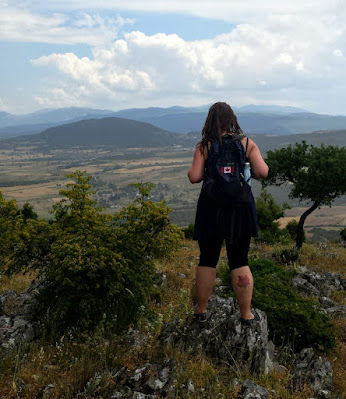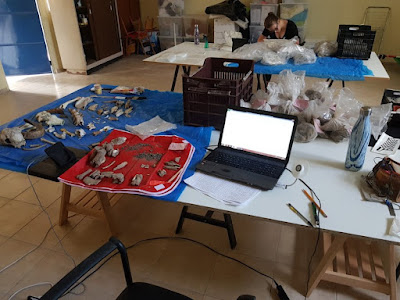Why Animal Bone?
Animal bones recovered from archaeological sites are traditional sources for showing which animals were regionally available in antiquity, what may have been eaten by the humans who lived at each site, and in the case of Kastro Kallithea, what animals may have been involved in a by-product based economy. The faunal materials for the domestic structure of Building 10 were previously analyzed by Professor Michael MacKinnon and we have been working with his data since 2016. Our newly renovated workspace, ‘Αποθήκη Β’, is the perfect setup to analyze fragments of bone from different contexts at Kastro Kallithea. Katherine is also analyzing materials from contexts at two Classical and Hellenistic dwellings at the nearby site of Farsala. Thanks to an abundance of modern materials around Narthaki, and previous student interests, we have a small “reference collection” to aid in the analysis of heavily fragmented remains.
For her doctoral research Katherine is interested in the high prevalence of sheep and goat materials at Kastro Kallithea, which account for over two-thirds of all recovered remains. The relative assortment of all elements recovered from young and old animals suggests that Kallithea was occupied year-round. Despite this, Katherine is attempting to show that shepherds and their flocks seasonally grazed throughout the Óthrys Mountains and plains around Thessaly. For her thesis Magie is analyzing the second-most abundant species: pig. Pigs are one of the only domesticated species kept solely for their meat resources. Because their meat was a common source for sacrifice, Magie is interested in analyzing whether ancient pigs were fed unique foods, managed differently than other domesticated animals, or if they were herded like the sheep and goat flocks around Thessaly. To investigate these questions we have had to look at non-traditional means.Biochemical Analysis and the Human-Animal Relationship
We use stable isotope analyses of animal bones and teeth to biochemically record what animals were eating during ancient times. Our methods are based on the notion “you are what you eat.” The food you eat and the water you drink have biochemical markers unique to the type of foods consumed and the location or season it grew in. As your bones and teeth grow and develop they incorporate these specific markers and store them like a fingerprint. A sheep that grazes on grass on Mount Óthrys will have different stable isotope values (isotopic fingerprint) than a pig that eats corn grown in Farsala. Magie is analyzing pig remains to record patterns and differences in diet at different contexts at Kastro Kallithea. These data will serve as the basis for her to analyze how pigs were managed during the Hellenistic period. Alternatively, Katherine is analyzing sheep and goat teeth at Kastro Kallithea and Farsala. Teeth grow in successive intervals, which can be microsampled and analyzed to indicate diet and location at specific points throughout the year. With these data Katherine is establishing whether sheep and goats were mobile throughout the year, and if their movement was seasonal. In 2016 Katherine collected all of the teeth necessary to conduct her analyses. This season Magie collected all of the pig bones that she needed to complete her analyses. Thanks to the support of the Ephorate and the CIG we were able to transport all materials back to the lab space in Edmonton.
Modern Observations
There are a lot of benefits of working in Thessaly while collecting our samples and surveying the recorded materials:
- We can observe the full collection of animal bones, artefacts, and other collected materials;
- We can visit the site in person and get a better sense of the landscape, spatial network, and context;
- We can discuss the context with the original excavators; and,
- We can observe modern domestic animals in the habitat we are analyzing
This year we were fortunate enough to witness a shepherd in his tractor, managing his flock using whistles as he sat in the driver’s seat. Despite the modernization of shepherding, it highlights the variation of shepherding styles in our small village of Narthaki, which makes us aware that animal management, and the human-animal relationships of the past, are not always uniform or straightforward.We thank the people of Narthaki for their continued support, interest in our project, and for welcoming us to our “summer home” year after year. Ευχαριστώ πολύ!
Katherine Bishop and Magie Aiken
University of Alberta











No comments:
Post a Comment